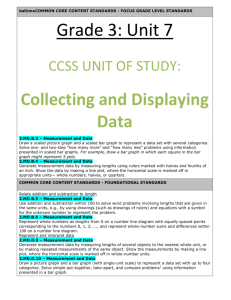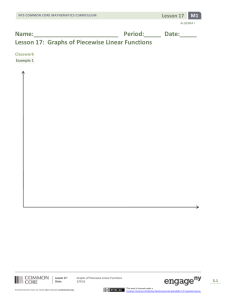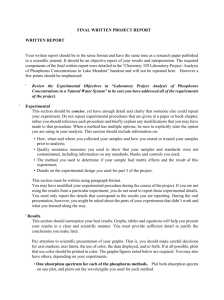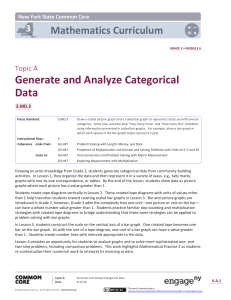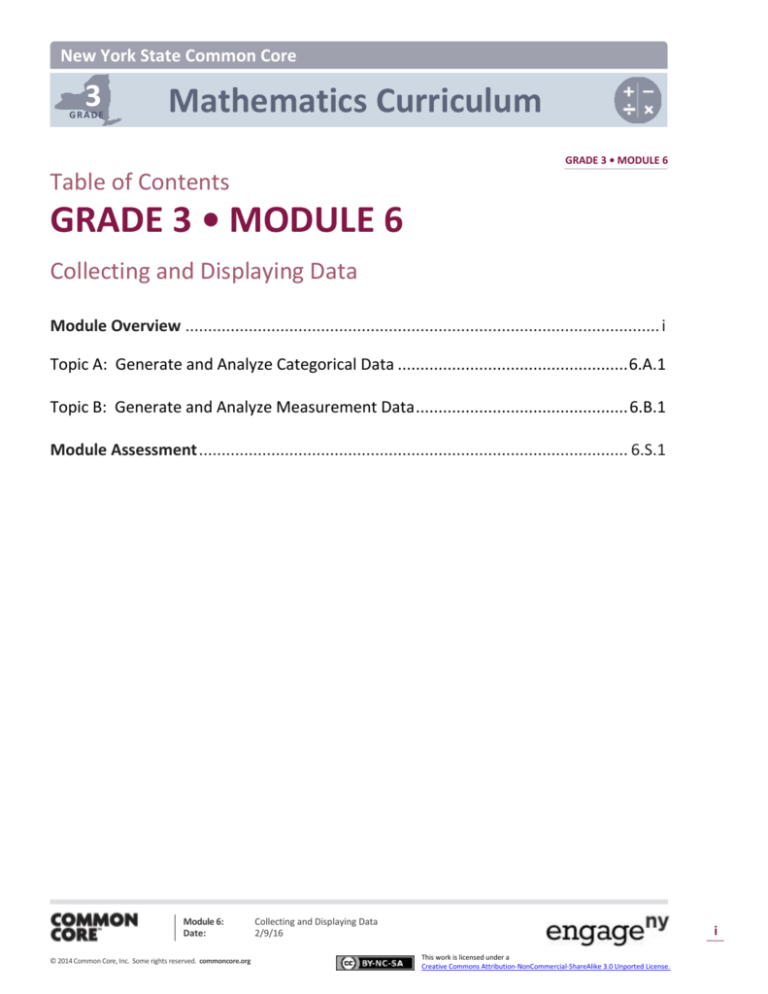
New York State Common Core
3
GRADE
Mathematics Curriculum
GRADE 3 • MODULE 6
Table of Contents
GRADE 3 • MODULE 6
Collecting and Displaying Data
Module Overview ......................................................................................................... i
Topic A: Generate and Analyze Categorical Data ................................................... 6.A.1
Topic B: Generate and Analyze Measurement Data ............................................... 6.B.1
Module Assessment ............................................................................................... 6.S.1
Module 6:
Date:
© 2014 Common Core, Inc. Some rights reserved. commoncore.org
Collecting and Displaying Data
2/9/16
i
This work is licensed under a
Creative Commons Attribution-NonCommercial-ShareAlike 3.0 Unported License.
NYS COMMON CORE MATHEMATICS CURRICULUM
3 6
Module Overview Lesson
New York State Common Core
Grade 3 • Module 6
Collecting and Displaying Data
OVERVIEW
This 10-day module builds on Grade 2 concepts about data, graphing, and line plots. Topic A begins with a
lesson in which students generate categorical data, organize it, and then represent it in a variety of forms.
Drawing on Grade 2 knowledge, students might initially use tally marks, tables, or graphs with one-to-one
correspondence. By the end of the lesson, they show data in tape diagrams where units are equal groups
with a value greater than 1. In the next two lessons, students rotate the tape diagrams vertically so that the
tapes become the units or bars of scaled graphs (3.MD.3). Students understand picture and bar graphs as
vertical representations of tape diagrams and apply well-practiced skip-counting and multiplication strategies
to analyze them. In Lesson 4, students synthesize and apply learning from Topic A to solve one- and two-step
problems. Through problem solving, opportunities naturally surface for students to make observations,
analyze, and answer questions such as, "How many more?" or "How many less?" (3.MD.3).
In Topic B, students learn that intervals do not have to be whole numbers but can have fractional values that
facilitate recording measurement data with greater precision. In Lesson 5, they generate a six-inch ruler
marked in whole-inch, half-inch, and quarter-inch increments, using the Module 5 concept of partitioning a
whole into parts. This creates a conceptual link between measurement and recent learning about fractions.
Students then use the rulers to measure the lengths of precut straws and record their findings to generate
measurement data (3.MD.4).
Lesson 6 reintroduces line plots as a tool for displaying measurement data. Although familiar from Grade 2,
line plots in Grade 3 have the added complexity of including fractions on the number line (2.MD.9, 3.MD.4).
In this lesson, students interpret scales involving whole, half, and quarter units in order to analyze data. This
experience lays the foundation for them to create their own line plots in Lessons 7 and 8. To draw line plots,
students learn to choose appropriate intervals within which to display a particular set of data. For example,
to show measurements of classmates’ heights, students might notice that their data fall within the range of
45 to 55 inches and then construct a line plot with the corresponding interval.
Students end the module by applying learning from Lessons 1–8 to problem solving. They work with a
mixture of scaled picture graphs, bar graphs, and line plots to problem solve using both categorical and
measurement data (3.MD.3, 3.MD.4).
Module 6:
Date:
© 2014 Common Core, Inc. Some rights reserved. commoncore.org
Collecting and Displaying Data
2/9/16
ii
This work is licensed under a
Creative Commons Attribution-NonCommercial-ShareAlike 3.0 Unported License.
NYS COMMON CORE MATHEMATICS CURRICULUM
3 6
Module Overview Lesson
New York State Common Core
Focus Grade Level Standards
Represent and interpret data.
3.MD.3
Draw a scaled picture graph and a scaled bar graph to represent a data set with several
categories. Solve one- and two-step “how many more” and “how many less” problems using
information presented in scaled bar graphs. For example, draw a bar graph in which each
square in the bar graph might represent 5 pets.
3.MD.4
Generate measurement data by measuring lengths using rulers marked with halves and
fourths of an inch. Show the data by making a line plot, where the horizontal scale is marked
off in appropriate units—whole numbers, halves, or quarters.
Foundational Standards
2.MD.5
Use addition and subtraction within 100 to solve word problems involving lengths that are
given in the same units, e.g., by using drawings (such as drawings of rulers) and equations
with a symbol for the unknown number to represent the problem.
2.MD.6
Represent whole numbers as lengths from 0 on a number line diagram with equally spaced
points corresponding to the numbers 0, 1, 2, ..., and represent whole-number sums and
differences within 100 on a number line diagram.
2.MD.9
Generate measurement data by measuring lengths of several objects to the nearest whole
unit, or by making repeated measurements of the same object. Show the measurements by
making a line plot, where the horizontal scale is marked off in whole-number units.
2.MD.10 Draw a picture graph and a bar graph (with single-unit scale) to represent a data set with up
to four categories. Solve simple put-together, take-apart, and compare problems1 using
information presented in a bar graph.
1
See Glossary, Table 1
Module 6:
Date:
© 2014 Common Core, Inc. Some rights reserved. commoncore.org
Collecting and Displaying Data
2/9/16
iii
This work is licensed under a
Creative Commons Attribution-NonCommercial-ShareAlike 3.0 Unported License.
3 6
Module Overview Lesson
NYS COMMON CORE MATHEMATICS CURRICULUM
New York State Common Core
Focus Standards for Mathematical Practice
MP.2
Reason abstractly and quantitatively. Students work with data in the context of science and
other content areas and interpret measurement data using line plots. Students
decontextualize data to create graphs and then contextualize as they analyze their
representations to solve problems.
MP.5
Use appropriate tools strategically. Students create and use rulers marked in inches, half
inches, and quarter inches. Students plot measurement data on a line plot and reason about
the appropriateness of a line plot as a tool to display fractional measurements.
MP.6
Attend to precision. Students generate rulers using precise measurements and then measure
lengths to the nearest quarter inch to collect and record data. Students label axes on graphs
to clarify the relationship between quantities and units and attend to the scale on the graph
to precisely interpret the quantities involved.
MP.7
Look for and make use of structure. Students use an auxiliary line to create equally spaced
increments on a six-inch strip, which is familiar from the previous module. Students look for
trends in data to help solve problems and draw conclusions about the data.
Overview of Module Topics and Lesson Objectives
Standards Topics and Objectives
3.MD.3
3.MD.4
Days
A Generate and Analyze Categorical Data
Lesson 1:
Generate and organize data.
4
Lesson 2:
Rotate tape diagrams vertically.
Lesson 3:
Create scaled bar graphs.
Lesson 4:
Solve one- and two-step problems involving graphs.
B Generate and Analyze Measurement Data
5
1
1-inch, 2
1
and 4
Lesson 5:
Create ruler with
inch,
generate measurement data.
inch intervals, and
Lesson 6:
Interpret measurement data from various line plots.
Lessons 7–8:
Represent measurement data with line plots.
Lesson 9:
Analyze data to problem solve.
End-of-Module Assessment: Topics A–B (assessment ½ day, return ¼ day,
remediation or further applications ¼ day)
Total Number of Instructional Days
Module 6:
Date:
© 2014 Common Core, Inc. Some rights reserved. commoncore.org
1
10
Collecting and Displaying Data
2/9/16
iv
This work is licensed under a
Creative Commons Attribution-NonCommercial-ShareAlike 3.0 Unported License.
3 6
Module Overview Lesson
NYS COMMON CORE MATHEMATICS CURRICULUM
New York State Common Core
Terminology
New or Recently Introduced Terms
Frequent (most common measurement on a line plot)
Key (notation on a graph explaining the value of a unit)
Measurement data (e.g., length measurements of a collection of pencils)
Scaled graphs (bar or picture graph in which the scale uses units with a value greater than 1)
Familiar Terms and Symbols2
Bar graph (graph generated from categorical data with bars to represent a quantity)
Data (information)
Fraction (numerical quantity that is not a whole number, e.g., 3)
Line plot (display of measurement data on a horizontal line)
Picture graph (graph generated from categorical data with graphics to represent a quantity)
Scale (a number line used to indicate the various quantities represented in a bar graph)
Survey (collecting data by asking a question and recording responses)
1
Suggested Tools and Representations
2
Bar graph
Grid paper
Line plot
Picture graph
Rulers (measuring in inches, half inches, and quarter inches)
Sentence strips
Tape diagram
These are terms and symbols students have seen previously.
Module 6:
Date:
© 2014 Common Core, Inc. Some rights reserved. commoncore.org
Collecting and Displaying Data
2/9/16
v
This work is licensed under a
Creative Commons Attribution-NonCommercial-ShareAlike 3.0 Unported License.
3 6
Module Overview Lesson
NYS COMMON CORE MATHEMATICS CURRICULUM
New York State Common Core
Scaffolds3
The scaffolds integrated into A Story of Units give alternatives for how students access information as well as
express and demonstrate their learning. Strategically placed margin notes are provided within each lesson
elaborating on the use of specific scaffolds at applicable times. They address many needs presented by
English language learners, students with disabilities, students performing above grade level, and students
performing below grade level. Many of the suggestions are organized by Universal Design for Learning (UDL)
principles and are applicable to more than one population. To read more about the approach to
differentiated instruction in A Story of Units, please refer to “How to Implement A Story of Units.”
Assessment Summary
Type
End-of-Module
Assessment Task
Administered
After Topic B
Format
Standards Addressed
Constructed response with rubric
3.MD.3
3.MD.4
*Because this module is short, there is no Mid-Module Assessment. Module 6 should normally be complete just prior to the
state assessment. This may not be true, however, depending on variations in pacing. In the case that it is not true, be aware
that 3.MD.3 (addressed in Topic A) is a pretest standard, while 3.MD.4 (addressed in Topic B) is a post-test standard.
3
Students with disabilities may require Braille, large print, audio, or special digital files. Please visit the website
www.p12.nysed.gov/specialed/aim for specific information on how to obtain student materials that satisfy the National Instructional
Materials Accessibility Standard (NIMAS) format.
Module 6:
Date:
© 2014 Common Core, Inc. Some rights reserved. commoncore.org
Collecting and Displaying Data
2/9/16
vi
This work is licensed under a
Creative Commons Attribution-NonCommercial-ShareAlike 3.0 Unported License.

